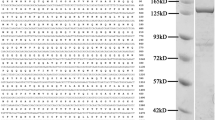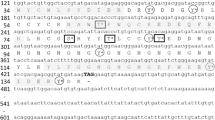Abstract
Mantle can secret matrix proteins playing key roles in regulating the process of shell formation. The genes encoding lysine-rich matrix proteins (KRMPs) are one of the most highly expressed matrix genes in pearl oysters. However, the expression pattern of KRMPs is limited and the functions of them still remain unknown. In this study, we isolated and identified six new members of lysine-rich matrix proteins, rich in lysine, glycine and tyrosine, and all of them are basic matrix proteins. Combined with four members of the KRMPs previously reported, all these proteins can be divided into three subclasses according to the results of phylogenetic analyses: KRMP1–3 belong to subclass KPI, KRMP4–5 belong to KPII, and KRMP6–10 belong to KPIII. Three subcategories of lysine-rich matrix proteins are highly expressed in the D-phase, the larvae and adult mantle. Lysine-rich matrix proteins are involved in the shell repairing process and associated with the formation of the shell and pearl. What’s more, they can cause abnormal shell growth after RNA interference. In detail, KPI subgroup was critical for the beginning formation of the prismatic layer; both KPII and KPIII subgroups participated in the formation of prismatic layer and nacreous layer. Compared with different temperatures and salinity stimulation treatments, the influence of changes in pH on KRMPs gene expression was the greatest. Recombinant KRMP7 significantly inhibited CaCO3 precipitation, changed the morphology of calcite, and inhibited the growth of aragonite in vitro. Our results are beneficial to understand the functions of the KRMP genes during shell formation.










Similar content being viewed by others
Reference
Addadi L, Joester D, Nudelman F, Weiner S (2006) Mollusk shell formation: a source of new concepts for understanding biomineralization processes. Chemistry 12:980–987
Belton D, Paine G, Patwardhan SV, Perry CC (2004) Towards an understanding of (bio) silicification: the role of amino acids and lysine oligomers in silicification. J Mater Chem 14:2231–2241
Berland S, Marie A, Duplat D, Milet C, Sire JY, Bedouet L (2011) Coupling proteomics and transcriptomics for the identification of novel and variant forms of mollusk shell proteins: a study with P. margaritifera. Chembiochem 12:950–961
Fang D, Xu G, Hu Y, Pan C, Xie L, Zhang R (2011) Identification of genes directly involved in shell formation and their functions in pearl oyster, Pinctada fucata. PLoS One 6:e21860
Fang D, Pan C, Lin H, Lin Y, Zhang G, Wang H, He M, Xie L, Zhang R (2012) Novel basic protein, PfN23, functions as key macromolecule during nacre formation. J Biol Chem 287:15776–15785
Farre B, Dauphin Y (2009) Lipids from the nacreous and prismatic layers of two Pteriomorpha mollusc shells. Comp Biochem Physiol B Biochem Mol Biol 152:103–109
Gardner LD, Mills D, Wiegand A, Leavesley D, Elizur A (2011) Spatial analysis of biomineralization associated gene expression from the mantle organ of the pearl oyster Pinctada maxima. BMC Genomics 12:455
Inoue N, Ishibashi R, Ishikawa T, Atsumi T, Aoki H, Komaru A (2011) Gene expression patterns in the outer mantle epithelial cells associated with pearl sac formation. Mar Biotechnol 13:474–483
Jackson DJ, McDougall C, Woodcroft B, Moase P, Rose RA, Kube M, Reinhardt R, Rokhsar DS, Montagnani C, Joubert C (2010) Parallel evolution of nacre building gene sets in molluscs. Mol Biol Evol 27:591–608
Kinoshita S, Wang N, Inoue H, Maeyama K, Okamoto K, Nagai K, Kondo H, Hirono I, Asakawa S, Watabe S (2011) Deep sequencing of ESTs from nacreous and prismatic layer producing tissues and a screen for novel shell formation-related genes in the pearl oyster. PLoS One 6:e21238
Li C, Hu Y, Liang J, Kong Y, Huang J, Feng Q, Li S, Zhang G, Xie L, Zhang R (2010) Calcineurin plays an important role in the shell formation of pearl oyster (Pinctada fucata). Mar Biotechnol 12:100–110
Liu X, Li J, Xiang L, Sun J, Zheng G, Zhang G, Wang H, Xie L, Zhang R (2012) The role of matrix proteins in the control of nacreous layer deposition during pearl formation. Proc R Soc Lond Ser B Biol Sci 279:1000–1007
Lowenstam HA, Weiner S (1989) On biomineralization. Oxford University Press, New York
Luquet G (2012) Biomineralizations: insights and prospects from crustaceans. Zookeys 176:103–121
Mann S (2001) Biomineralization. Oxford University Press, Oxford
Marie B, Zanella-Cleon I, Corneillat M, Becchi M, Alcaraz G, Plasseraud L, Luquet G, Marin F (2011) Nautilin-63, a novel acidic glycoprotein from the shell nacre of Nautilus macromphalus. FEBS J 278:2117–2130
Marie B, Joubert C, Tayalé A, Zanella-Cléon I, Belliard C, Piquemal D, Cochennec-Laureau N, Marin F, Gueguen Y, Montagnani C (2012) Different secretory repertoires control the biomineralization processes of prism and nacre deposition of the pearl oyster shell. Proc Natl Acad Sci U S A 109:20986–20991
Marin F, Luquet G, Marie B, Medakovic D (2008) Molluscan shell proteins: primary structure, origin, and evolution. Curr Top Dev Biol 80:209–276
Marin F, Le Roy N, Marie B (2012) The formation and mineralization of mollusk shell. Front Biosci (Schol Ed) S4:1099–1125
Masaoka T, Kobayashi T (2009) Analysis of nucleotide variation and inheritance of lysine-rich matrix protein (KRMP) genes participating in shell formation of pearl oyster. DNA Polymorphism 17:126–135
McDougall C, Aguilera F, Moase P, Lucas JS, Degnan BM (2013a) Pearls. Curr Biol 23:R671–R673
McDougall C, Aguilera F, Degnan BM (2013b) Rapid evolution of pearl oyster shell matrix proteins with repetitive, low-complexity domains. J R Soc Interface 10:20130041
Miyazaki Y, Nishida T, Aoki H, Samata T (2010) Expression of genes responsible for biomineralization of Pinctada fucata during development. Comp Biochem Physiol B Biochem Mol Biol 155:241–248
Samata T, Hayashi N, Kono M, Hasegawa K, Horita C, Akera S (1999) A new matrix protein family related to the nacreous layer formation of Pinctada fucata. FEBS Lett 462:225–229
Simkiss K, Wilbur K (1989) Biomineralization. Cell biology and mineral deposition. Academic Press, San Diego
Suzuki M, Nagasawa H (2007) The structure-function relationship analysis of Prismalin-14 from the prismatic layer of the Japanese pearl oyster, Pinctada fucata. FEBS J 274:5158–5166
Suzuki M, Nagasawa H (2013) Mollusk shell structures and their formation mechanism. Can J Zool 91:349–366
Suzuki M, Murayama E, Inoue H, Ozaki N, Tohse H, Kogure T, Nagasawa H (2004) Characterization of Prismalin-14, a novel matrix protein from the prismatic layer of the Japanese pearl oyster (Pinctada fucata). Biochem J 382:205–213
Suzuki M, Saruwatari K, Kogure T, Yamamoto Y, Nishimura T, Kato T, Nagasawa H (2009) An acidic matrix protein, Pif, is a key macromolecule for nacre formation. Science 325:1388–1390
Takeuchi T, Sarashina I, Iijima M, Endo K (2008) In vitro regulation of CaCO3 crystal polymorphism by the highly acidic molluscan shell protein Aspein. FEBS Lett 582:591–596
Tamura K, Peterson D, Peterson N, Stecher G, Nei M, Kumar S (2011) MEGA5: molecular evolutionary genetics analysis using maximum likelihood, evolutionary distance, and maximum parsimony methods. Mol Biol Evol 28:2731–2739
Xiang L, Su J, Zheng G, Liang J, Zhang G, Wang H, Xie L, Zhang R (2013) Patterns of expression in the matrix proteins responsible for nucleation and growth of aragonite crystals in flat pearls of Pinctada fucata. PLoS One 8:e66564
Yan Z, Jing G, Gong N, Li C, Zhou Y, Xie L, Zhang R (2007) N40, a novel nonacidic matrix protein from pearl oyster nacre, facilitates nucleation of aragonite in vitro. Biomacromolecules 8:3597–3601
Yano M, Nagai K, Morimoto K, Miyamoto H (2006) Shematrin: a family of glycine-rich structural proteins in the shell of the pearl oyster Pinctada fucata. Comp Biochem Physiol B Biochem Mol Biol 144:254–262
Zhang C, Xie L, Huang J, Liu X, Zhang R (2006) A novel matrix protein family participating in the prismatic layer framework formation of pearl oyster, Pinctada fucata. Biochem Biophys Res Commun 344:735–740
Author information
Authors and Affiliations
Corresponding authors
Ethics declarations
Funding
This work was supported by the National Natural Science Foundation of China Grants 31372502 and 31572594 and Independent Research Projects of Tsinghua University Grant 20111080964.
Conflict of Interest
The authors declare that they have no conflict of interest.
Electronic supplementary material
ESM 1
(DOCX 86 kb)
Fig. S1
Purification of recombinant KRMP7. Arrows represent the proteins induced by IPTG and confirmed by Western blot. (GIF 19 kb)
Fig. S2
The position of qPCR primers in KRMP nucleotide sequences. The black single underline, bold underline, and double underline indicate primers qKPIF/qKPIR, qKPIIF/qKPIIR and qKPIIIF/qKPIIIR, respectively. (GIF 227 kb)
Rights and permissions
About this article
Cite this article
Liang, J., Xie, J., Gao, J. et al. Identification and Characterization of the Lysine-Rich Matrix Protein Family in Pinctada fucata: Indicative of Roles in Shell Formation. Mar Biotechnol 18, 645–658 (2016). https://doi.org/10.1007/s10126-016-9724-6
Received:
Accepted:
Published:
Issue Date:
DOI: https://doi.org/10.1007/s10126-016-9724-6




